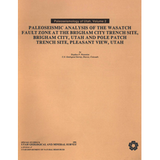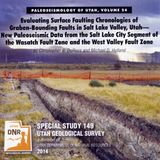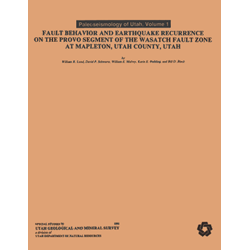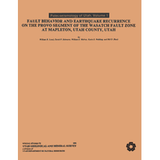Paleoseismology of Utah, Volume 1: Fault behavior and earthquake recurrence on the Provo segment of the Wasatch fault zone at Mapleton, Utah County, Utah (SS-75)
By: W. R. Lund, D. P. Schwartz, W. E. Mulvey, K. E. Budding, and B. D. Black
This report on the Holocene behavior of the Provo segment of the Wasatch fault zone near Mapleton, Utah is the first in the Utah Geological and Mineral Survey Paleoseismology of Utah Special Studies series. Paleoseismology is the study of prehistoric earthquakes. Only large earthquakes that cause co-seismic surface rupture or otherwise disturb the ground surface (liquefaction, earthquake-induced landslides, tectonic subsidence) leave evidence in the geologic record of their occurrence. Paleoseismic investigations commonly include mapping of fault scarps and associated geologic deposits, trenching across active fault traces, geomorphic analysis of fault-related or fault-modified features, and investigation of fault-zone structures in both consolidated and unconsolidated deposits. Techniques for dating Quaternary sediments are used to constrain the timing of past events. The resulting information on earthquake timing, recurrence, displacement, and fault geometry permit the characterization of seismic source zones and determination of the long-term earthquake potential of Quaternary faults. Information on the size and timing of paleoearthquakes and on the ground deformation that accompanies them is fundamental to the evaluation of earthquake hazards and risk.
Other Information:
Published: 1991
Pages: 41 p.
Location: Utah County
Media Type: Paper Publication









